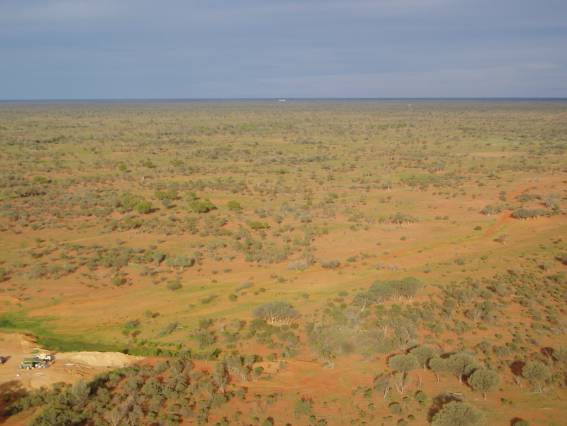SKA program report
Submission of SKA and LOFAR proposals
On 31 May 2003 the initial Australian SKA-siting proposal and the two updated Australian SKA-concept proposal whitepapers were submitted to the International SKA Steering Committee (ISSC). The SKA-siting proposal suggests three primary candidate SKA sites, Mileura in Western Australia (WA), Murnpeowie in South Australia (SA) and Reola in New South Wales (NSW), and a representative secondary candidate SKA site at Parkes in NSW. All the primary sites are remote, extremely `quiet' at radio frequencies and have had their radio frequency environment measured. The secondary site is indicative of a typical Australian site that is closer to major infrastructure but is still radio quiet by world standards. The updated SKA-concept proposal whitepapers respond to both scientific and technical questions posed by the ISSC on the Luneberg Lens and Cylindrical Reflector Australian SKA concepts. A one-day SKA science workshop was held at the end of April to clarify the key science drivers for the concepts.
These substantial proposals followed closely after the submission of another major proposal on 15 May 2003 the submission of the LOFAR siting proposal to the LOFAR International Steering Committee. The LOFAR proposal was jointly prepared by CSIRO-ATNF and the Western Australia Government Office of Science and Innovation. It puts forth a site centred on Mileura (WA), with a data processing centre in Geraldton, as an ideal combination for the LOFAR telescope.
NSW SKA site characterization field tests

Figure 1: Aerial view towards the Reola homestead in New South Wales, The radio frequency test site can be seen in the bottom left corner.
Ron Beresford and two contractors from Compucat Pty Ltd visited the remote Reola station (see picture above) in early May to characterize its radio-frequency environment. Early results indicate that Reola is an extremely radio-quiet site. This work was jointly funded by the ATNF and the NSW Department of State and Regional Development.
Dielectrics materials and the prototype Luneberg Lens
Exciting results have been obtained with new dielectric material being produced for the prototype Luneberg Lens. Materials have been produced with a dielectric constant of 1.7 and loss tangent less than 0.0001, corresponding to a noise loading less than 6 K per GHz. This dielectric constant exceeds that required by the Luneberg Lens specifications; while the loss is so low that operation of the lens may be possible above the initial 10-GHz estimate. The patent for the new material has been finalized and will be submitted soon. A one-metre diameter lens is due to be constructed from the new material by mid-year. Good progress is being made with the lens-feed translator system, with the system also expected to be operational by mid-year.
Digital phased array, radio-on-chip and MMIC work
Work has commenced on the digital phased array and radio-on-chip technology projects with collaborations being formed between ATNF, Macquarie University and CISCO Systems to pursue research in this area. Suzy Jackson, from the ATNF, has commenced a PhD project in this field. Phased arrays are being explored as an alternative multibeaming antenna solution for the SKA. They are highly competitive below 1.5 GHz, but do not replace Luneberg lenses in the 1 - 10 GHz range. The concept of using a phased array in the focal plane of a concentrating antenna, such as Parkes or a Luneberg lens, is also being explored. A major new collaborative project between ATNF, ASTRON and the CEA phased-array radar company has been formed to evaluate the Luneberg lens and focal-plane array combination as a basis for larger-scale prototyping. Meanwhile, a European company has expressed interest in the broadband 2 - 8 GHz LNA MMIC that Aaron Chippendale has been working on.
IAU and SKA 2003 international meetings
Planning logistics as well as science and engineering contributions for the IAU and SKA 2003 international meetings are becoming important. There will be several stands at the IAU focussing on SKA activities. The Australian SKA Consortium will host a stand covering Australian SKA work including the Luneberg Lens and Cylindrical Reflector Australian SKA-concept proposals, proposed Australian SKA sites, SKA simulation work, outreach activities and industry involvement. The SKA 2003 international meeting in Geraldton promises to be a stimulating event with over 100 participants already registered. Major discussions will be held on the scientific and technological potentials of the various SKA concepts and several working groups will discuss specific components of the SKA system design. More details can be found on the meeting website at www.atnf.csiro.au/projects/ska/events/geraldton/ .
Directions
Looking to the future, the ATNF group is aiming to continue to have a major impact on world SKA directions with a high, and increasing, emphasis on SKA siting. A convergence of the form of the MNRF SKA demonstrator will take place as the various technology options are evaluated. The demonstrator may involve international links with, for example, ASTRON. Meanwhile the group will be involved in assisting with the commercialization of the new dielectric materials and Luneberg lenses regardless of whether lenses are eventually used in the SKA application.
Finally, on personnel matters, Dr George "Nyima" Warr has joined us on a 12-month appointment as an SKA/LOFAR strategic support scientist, while Adam Deller, an industrial based learning student from Swinburne University of Technology, is with us until the end of July. Adam is working on the motion control system for a prototype Luneberg lens antenna.
George "Nyima" Warr (Strategic Support Scientist) and Peter Hall (SKA Program Leader)
(George.Warr@csiro.au, Peter.Hall@csiro.au)
